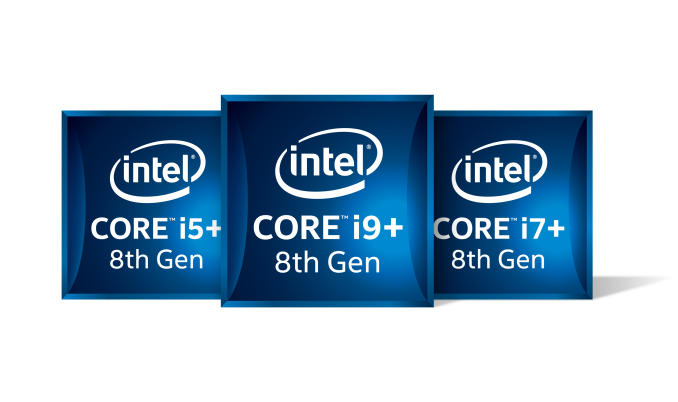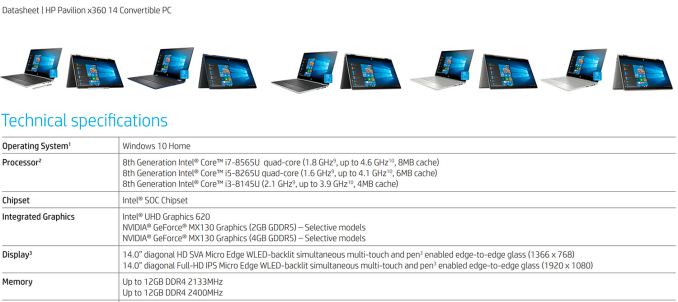Intel 15 Watt Whiskey Lake CPU Specs Disclosed Early: i7-8565U, i5-8265U, & i3-8145U
by Anton Shilov on August 9, 2018 1:00 PM EST
As the formal launch of Intel’s new codenamed Whiskey Lake-U processors approaches, it is seemingly inevitable that their model numbers and specifications will get published by OEMs ahead of time. This week HP has done just that, inadvertently publishing the frequencies of some of the upcoming processors, all the while ASUS and Synnex have confirmed their model numbers as well as some other specs. As it appears, Intel has managed to increase Turbo clocks of the new chips rather significantly when compared to their predecessors.
Intel first announced its Whiskey Lake-U processors for mobile PCs back in April and then shed some light on these chips at Computex. According to Intel, the CPUs will belong to its 8th Generation Core family, will be made using a 14 nm process technology, and will offer a double-digit performance gains when compared to the Kaby Lake Refresh parts. It is unclear whether the Whiskey Lake-U processors have any microarchitectural improvements over their ancestors, but this week we learned that they will at least have higher Turbo frequencies.
HP on Wednesday accidentally published specs of its upcoming Pavilion x360 convertible based on the Whiskey Lake-U SoC and disclosed specs of the chips it plans to use. In the meantime, ASUS and Synnex (1, 2) confirmed existence of CPUs with such model numbers.
As it turns out, HP will offer three Whiskey Lake-U processors with its Pavilion x360 notebooks: the quad-core Core i7-8565U, the quad-core Core i5-8265U, as well as the dual-core Core i3-8145U. HP’s disclosure indicates that all of these SoCs feature Intel’s UHD 620 iGPU with 24 EUs, so at least on the graphics front Whiskey Lake-U will offer similar features as their predecessors. In the meantime, specs published by ASUS indicate that the new CPUs will support DDR4-2667 memory, thus offering an upgrade.
If we compare alleged specs of the upcoming Whiskey Lake-U processors with comparable Kaby Lake Refresh chips, we will notice that the new SoCs do not have any advantages in terms of base frequencies, but feature massively higher turbo clocks, on the order of 500 to 700 MHz. The latter will have an impact on responsiveness of future laptops, but under prolonged heavy loads such PCs may not perform much differently than systems featuring KBL-R CPUs.
| General Specifications of Intel's 2017/2018 Mainstream Notebook CPUs | |||||||||||||
| Whiskey Lake-U | Kaby Lake Refresh | ||||||||||||
| Cores | Freq. Base |
Freq. Turbo |
L3 | TDP | Cores | Freq. Base |
Freq. Turbo |
L3 | TDP | ||||
| Core i7-8565U | 4 | 1.8 GHz | 4.6 GHz | 8 MB | 15 W | Core i7-8550U | 4 | 1.8 GHz | 4 GHz |
8 MB | 15 W | ||
| Core i5-8265U | 1.6 GHz | 4.1 GHz | 6 MB | Core i5-8250U | 1.6 GHz | 3.4 GHz | 6 MB | ||||||
| Core i3-8145U | 2 | 2.1 GHz | 3.9 GHz | 4 MB | Core i3-8130U | 2 | 2.2 GHz | 3.4 GHz | 4 MB | ||||
Intel traditionally does not comment on unreleased products and therefore it is impossible to verify accuracy of the specs published by HP.
Related Reading:
- Intel Discuss Whiskey Lake-U, Amber Lake-Y, and ‘Cascade Lake-X’
- Intel 10nm Production Update: Systems on Shelves For Holiday 2019
- Intel Delays Mass Production of 10 nm CPUs to 2019
- Intel’s Crimson Canyon NUCs with Cannon Lake CPU & Radeon dGPU Available for Pre-Order
Sources: Tom’s Hardware, Notebookcheck.net











40 Comments
View All Comments
0iron - Thursday, August 9, 2018 - link
When we will see LPDDR4 coming to laptop? Why it takes so long...DanNeely - Thursday, August 9, 2018 - link
Apparently it's stuck in 10nm limbo with cannonlake.smilingcrow - Thursday, August 9, 2018 - link
Seems so and it's seemingly not as important as some make out as even Apple dumped LPDDR3 for DDR4 in their latest laptops so they jump from 16 to 32GB; 16GB being the limit for LPDDR3.abufrejoval - Friday, August 10, 2018 - link
How so? Have had 32GB in Skylake notebooks for years with DDR3... Just costs twice as much as it used to.yuhong - Friday, August 10, 2018 - link
LPDDR3 is different from DDR3.LMonty - Saturday, August 11, 2018 - link
Is this a documented limit for LPDDR3? There are 16GB LPDDR3 modules being sold by Crucial. If I put one in each of my laptop's 2 SODIMM slots, wouldn't that give me 32GB?LMonty - Saturday, August 11, 2018 - link
Oops correction, I just realized that LPDDR3 (1.2v) is not the same as DDR3L (1.35v). My laptop uses DDR3L.ikjadoon - Thursday, August 9, 2018 - link
The fruits of 14nm++, right? I wonder how they’ll deal with the higher idle draw. Is this where those low power displays (1W) come in?I can’t help but imagine Cannon Lake (10nm) will be a Broadwell (first 14nm arch): bad clocks, non-existent availability for ages, and an overall “forgotten” CPU line. Then Ice Lake (Skylake, in the analogy 14nm timeline) makes it usable.
Santoval - Friday, August 10, 2018 - link
At this point it is not even clear that Cannon Lake will actually be released (I mean in something more than a rare single low power 2-core sample with a.. disabled iGPU). In case it was not clear the expected high volume release of 10nm CPUs from Intel in the last couple of months of 2019 refers to Ice Lake, not Cannon Lake.These, as you might recall, are based on Intel's 10nm+ node, not 10nm. So it strongly looks like Intel will treat their first-gen 10nm node and Cannon Lake as nothing more than a beta node / CPU(s). They had serious issues with their (first-gen) 10nm node and ASML helped them overcome them. It appears that they are going to implement what they learnt in 10nm+ and Ice Lake, and thus skip 10nm and Cannon Lake. I would be greatly surprised if they released a second Cannon Lake CPU before the Ice Lake release.
HStewart - Thursday, August 9, 2018 - link
It sounds like they made some processing improvements with Whiskey Lake. For it to get double digit gains - and higher frequency at lower watt then 8705G they must have done something in power to performance ratio. But keep in my 8705G wattage is not just the CPU - but discrete GPU.I wonder if they will have 6 core version of Whiskey lake.